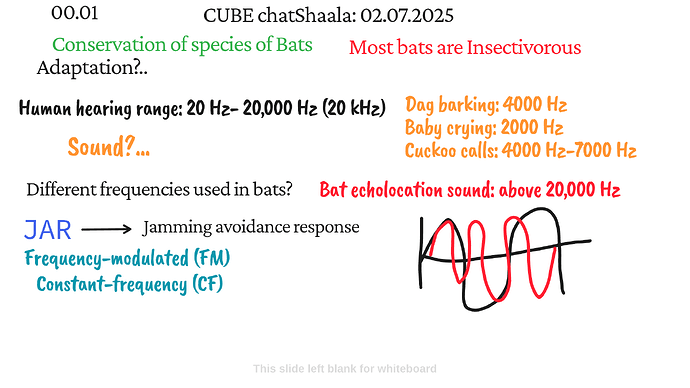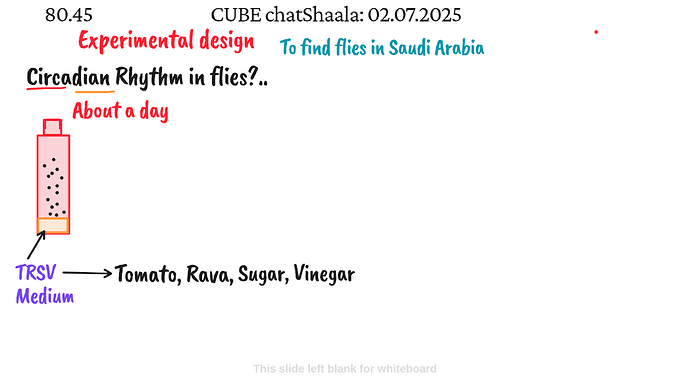![]() Session 1: Conservation & Echolocation in Bats
Session 1: Conservation & Echolocation in Bats
The introductory discussion centered on bat conservation, emphasizing their key ecological role as insect predators. A crucial adaptation—echolocation—was explained and contrasted with human-audible sounds ( 20 Hz–20 kHz ).
For context:
-
Dog bark: ~4 kHz
-
Baby cry: ~2 kHz
-
Cuckoo call: 4–7 kHz
Bat echolocation: above 20 kHz
The concept of jamming avoidance response (JAR) was introduced, highlighting bats’ ability to shift frequencies to minimize acoustic interference . Two echolocation call types were discussed:
![]() Frequency-Modulated (FM)— sweeping chirps
Frequency-Modulated (FM)— sweeping chirps
![]() Constant-Frequency (CF) — prolonged narrow tones, often used with Doppler shift compensation .
Constant-Frequency (CF) — prolonged narrow tones, often used with Doppler shift compensation .
These strategies help bats maintain clear sonar performance amidst overlapping calls .
![]() Session 2: Designing Fly Circadian Rhythm Experiments
Session 2: Designing Fly Circadian Rhythm Experiments
The second half shifted focus to experimental strategies for exploring circadian rhythms in fruit flies, possibly in locations like Saudi Arabia. Circadian rhythms—approximately 24‑hour biological cycles—were defined, and Drosophila melanogaster was identified as a key model organism.
An innovative TRSV medium was proposed for fly culture:
Tomato, Rava ,Sugar ,Vinegar
This cost-effective substrate supports trapping and breeding flies. The group sketched a vial setup for monitoring life cycle events, aiming to adapt classic lab methodologies ( e.g., activity monitors, actograms ) .
![]() Suggested Follow-Up Questions:
Suggested Follow-Up Questions:
On Bats :
-
How do FM and CF bats differ in implementing JAR when encountering overlapping echolocation calls?
-
What roles does Doppler-shift compensation play in CF species’ ability to stabilize echo perception?
-
Which ecological scenarios would make Bessel moths or tiger moths effective at jamming bat sonar?
On Fly Experiments :
-
What practical techniques could be used to track circadian patterns in flies using a simple TRSV assay and activity monitoring?
-
How might environmental variables—light, temperature, humidity—be managed in regions like Saudi Arabia to maintain consistent rhythm studies?
-
Could genetic variants ( e.g., period/per mutants ) be integrated into field-based experiments, and how would these contribute to our understanding of natural circadian variation?
![]() Reference
Reference
-
Jamming avoidance response of big brown bats in target detection - PubMed
-
New Study on the Circadian Clock of the Fruit Fly | Lab Manager
@Arunan @Susanta_Tanti @Shivani @Akantidas @Chitralekha @Nayanjyothi @KiranKalakotiR @AkhilGupta @akanksha @Mohod and others.

